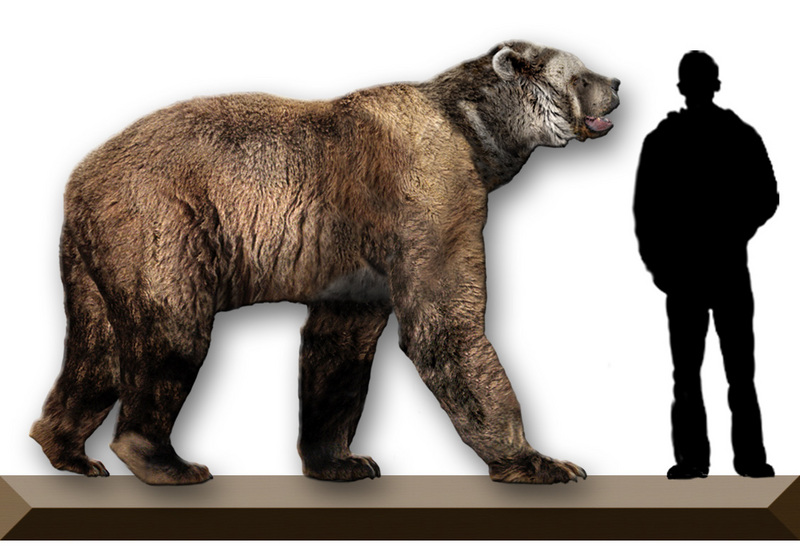| 새로운 사진 | 신문속의 동물소식 | 신기한 동물이야기 | 동물의 소리 | 동물동화상 | 사진 올리기 | 사진 저작권 | English |
|---|
| 재미있는 동물사진 | 괴수/괴어/엽기 동물사진 | 동물이름사전 | 동물목록 | 바깥고리 | 창고입구 | 똑똑누리집 |
|---|
| 이미지 정보 | Original File Name: Giant Short-Faced Bear (Arctodus simus) Reconstruct.jpg Resolution: 1128x788 File Size: 206133 Bytes Upload Time: 2007:11:13 11:37:06 | |
| 올린이 | 이름 (메일주소): Unknown | |
| 사진 제목 | Short-faced Bear (Family: Ursidae, Genus: Arctodus) - Wiki | |
 |
| Email : 카드 | 올린이 | 운영자 사진삭제 정보수정 Admin |
| 설명 | Short-faced Bear (Family: Ursidae, Genus: Arctodus) - Wiki
Arctodus
Scientific classification Kingdom: Animalia Phylum: Chordata Class: Mammalia Order: Carnivora Family: Ursidae Subfamily: Tremarctinae Genus: Arctodus Species: - Arctodus simus, Cope 1897 - Arctodus pristinus, Leidy, 1897 Arctodus, is also known as the Short-Faced Bear. One species, the Giant Short-Faced Bear (Arctodus simus), is the largest bear that ever lived based on fossil finds. It lived in prehistoric North America from about 800,000 to 12,500 years ago. Sub-family The short-faced bear belongs to a group of bears known as the Tremarctine bears, which are of New World origin. The earliest member of the Tremarctinae is Plionarctos, which lived in Texas during the Pliocene Epoch (about 5???2 million years ago). It is likely that this genus is ancestral to the Spectacled Bear (Tremarctos) and the short-faced bear. Although the early history of Arctodus is poorly known, it evidently became widespread in North America by the Kansan age (about 800,000 years ago). Physiology Arctodus simus stood as high as 183 cm (6.0 feet) at the shoulder on all four legs. When standing, the animal was over 3.35 m 11 feet). From the fossils found, the Giant short-faced bear was estimated to weigh up to 900 kg (2,000 pounds). Its contemporary was the Grizzly bear, yet it was twice its size. In build it was leaner than the Brown Bear. At one time it was the largest living terrestrial predatory mammal. It has been determined by Paul Matheus, Ph.D. of the University of Alaska-Fairbanks that Arctodus had a locomotion similar to that of a camel making it capable of traveling greater distances on fewer calories. The long legs enabled this bear to cover a large territory as fast as 51 km/h (32 mph), according to Dr. Matheus. Matheus however states that Arctodus could not have chased down prey as the bear's front leg bones could not hold up to the substantial weight of the animal if it made a quick turn. Arctodus had a very short, broad muzzle which gives rise to its name. The skull had an olfactory area twice as large as that of a Grizzly bear giving it the ability to identify a carcass from as far away as 9.5 km (6 miles). The jaw bone fulcrum point was further back in the head and allowed Arctodus to easily break and eat bones and marrow. Range Arctodus simus, the largest species, ranged the high grasslands of western North America from Alaska to Mexico, while a lighter-built species (Arctodus pristinus) with smaller teeth inhabited the more heavily wooded Atlantic coastal region. A skull was found by a Yukon gold miner. Another fossil from southern Saskatchewan indicates that Arctodus lived there more than 70,000 years ago. Prey Arctodus was a complete carnivore according to Dr. Matheus and an adult would have had to consume 15.8 kg (35 lbs) of meat daily to survive. Stable Isotope Analysis performed by Dr. Matheus showed no evidence of ingestion of vegetation and only consumption of meat. It was the biggest land scavenger during the Ice Age in North America and it was large for the specific purpose of intimidation according to Dr. Matheus. It most likely would smell a kill and force its competitors, Dire wolves and Saber cats, away from the kill. It fed on bison, mammoth, deer, elk, sloth, camel and other large herbivores. This practice of kleptoparasitism is used today as a food gathering technique, besides actual active hunting. Examples are the entelodont, Tyrannosaurus, the skuas, and the lion. The only competitor Arctodus would have retreated from was likely Megatherium, a herbivore that seems to have occasionally scavenged carcasses. Though Arctodus is considered a thief of food, it could have attacked a slow moving animal such as Megatherium (Giant Sloth) according to Greg McDonald, a paleontologist with the National Park Service. The battle between the two could have gone in favor of either animal depending on which animal wielded the element of surprise. The short-faced bear became extinct some 12,000 years ago, perhaps partly because some of its large prey died out earlier, and partly because of competition with the smaller, more herbivorous brown bears that entered North America from Eurasia. Since its demise coincides with the development of the Clovis technology and improved hunting techniques by humans in North America, hunting may also have contributed to its extinction both directly and due to the depletion of other large mammals on which it depended for food. http://en.wikipedia.org/wiki/Arctodus
| |||
| 저작권 정보 | 사진의 저작권은 원저작자에게 있습니다. 동물그림창고는 동물관련 사진을 전시할 수 있는 공간만을 제공합니다.사진을 사용하고자 할 경우에는 저작권자와 협의하시기 바랍니다. |
|
|
|
| |||||||
| CopyLeft © since 1995, 동물그림창고. All rights may be reserved. | ||||||||
Stats